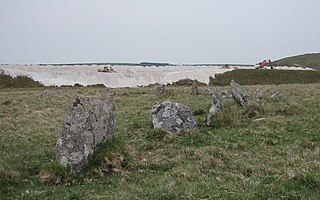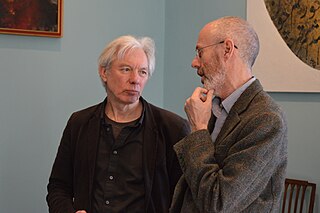Related Research Articles

Bodmin Moor is a granite moorland in north-eastern Cornwall,England. It is 208 square kilometres (80 sq mi) in size,and dates from the Carboniferous period of geological history. It includes Brown Willy,the highest point in Cornwall,and Rough Tor,a slightly lower peak. Many of Cornwall's rivers have their sources here. It has been inhabited since at least the Neolithic era,when primitive farmers started clearing trees and farming the land. They left their megalithic monuments,hut circles and cairns,and the Bronze Age culture that followed left further cairns,and more stone circles and stone rows. By medieval and modern times,nearly all the forest was gone and livestock rearing predominated.

Stonehenge is a prehistoric monument on Salisbury Plain in Wiltshire,England,two miles (3 km) west of Amesbury. It consists of an outer ring of vertical sarsen standing stones,each around 13 feet (4.0 m) high,seven feet (2.1 m) wide,and weighing around 25 tons,topped by connecting horizontal lintel stones. Inside is a ring of smaller bluestones. Inside these are free-standing trilithons,two bulkier vertical Sarsens joined by one lintel. The whole monument,now ruinous,is orientated towards the sunrise on the summer solstice. The stones are set within earthworks in the middle of the most dense complex of Neolithic and Bronze Age monuments in England,including several hundred tumuli.

Durrington Walls is the site of a large Neolithic settlement and later henge enclosure located in the Stonehenge World Heritage Site in England. It lies 2 miles (3.2 km) north-east of Stonehenge in the parish of Durrington,just north of Amesbury in Wiltshire. The henge is the second-largest Late Neolithic palisaded enclosure known in the United Kingdom,after Hindwell in Wales.
Chris Tilley is a British archaeologist known for his contributions to postprocessualist archaeological theory. He is currently a Professor of Anthropology and Archaeology at University College London.
Roger James Mercer was a British archaeologist whose work concentrated on the Neolithic and Bronze Age of the British Isles.
Michael Parker Pearson,is an English archaeologist specialising in the study of the Neolithic British Isles,Madagascar and the archaeology of death and burial. A professor at the UCL Institute of Archaeology,he previously worked for 25 years as a professor at the University of Sheffield in England,and was the director of the Stonehenge Riverside Project. A prolific author,he has also written a variety of books on the subject.
Caroline Malone is a British academic and archaeologist,former Professor of Prehistory at Queen's University,Belfast School of Natural and Built Environment http://www.qub.ac.uk/schools/nbe/,and formerly Senior Tutor of Hughes Hall,Cambridge,UK. Prior to this she was editor of Antiquity and Keeper of the Department of Prehistory and Early Europe at the British Museum. She began her career as curator at the Alexander Keillor Museum at Avebury.

Prehistory,also known as pre-literary history,is the period of human history between the use of the first stone tools by hominins c. 3.3 million years ago and the beginning of recorded history with the invention of writing systems. The use of symbols,marks,and images appears very early among humans,but the earliest known writing systems appeared c. 5000 years ago and it took thousands of years for writing systems to be widely adopted. In some human cultures,writing systems were not used until the nineteenth century and,in a few,are not even used until the present. The end of prehistory therefore came at very different dates in different places,and the term is less often used in discussing societies where prehistory ended relatively recently.
Julian Stewart Thomas is a British archaeologist,publishing on the Neolithic and Bronze Age prehistory of Britain and north-west Europe. Thomas has been vice president of the Royal Anthropological Institute since 2007,is a fellow of the Society of Antiquaries of London,has been professor of archaeology at the University of Manchester since 2000,and is former secretary of the World Archaeological Congress. Thomas is perhaps best known as the author of the academic publication Understanding the Neolithic in particular,and for his work with the Stonehenge Riverside Project.
In archaeology,phenomenology applies to the use of sensory experiences to view and interpret an archaeological site or cultural landscape. It first came to widespread attention among archaeologists with the publication of Christopher Tilley's A Phenomenology of Landscape (1994),in which he suggested it to be a useful technique that can be used to discover more about historical peoples and how they interact with the landscapes in which they live. He argued that,simply by looking at two-dimensional depictions of a landscape,such as on a map,archaeologists fail to understand how peoples living in hunter-gatherer and agricultural societies actually relate to those areas. He believed,therefore,that investigators should enter the very landscape that they are studying,and use their senses of sight,smell,and hearing to learn more about how historical peoples would have interpreted it.
Timothy Darvill OBE is an English archaeologist and author,best known for his publications on prehistoric Britain and his excavations in England,Wales,and the Isle of Man. He is Professor of Archaeology in the Faculty of Science and Technology Bournemouth University in England. In April 2008 he co-directed excavations within Stonehenge,together with Professor Geoffrey Wainwright and Dr Miles Russell,to examine the early stone structures on the site. The work featured heavily in a BBC Timewatch programme which examined the theory that Stonehenge was a prehistoric centre of healing. He was appointed OBE in the 2010 Queen's Birthday Honours.

Sue Hamilton is a British archaeologist and Professor of Prehistory at the UCL Institute of Archaeology. A material culture specialist and landscape archaeologist,she became the UCL Institute of Archaeology's first permanent female director in September 2014.

Craddock Moor Stone Circle or Craddock Moor Circle is a stone circle located near Minions on Bodmin Moor in Cornwall,UK. It is situated around half a mile Northwest of The Hurlers.

Stannon stone circle is a stone circle located near St. Breward on Bodmin Moor in Cornwall,England.

Fernacre,also known as Fernacre stone circle or Fernacre circle,is a stone circle located on the slopes of the De Lank River,1.25 miles (2.01 km) northeast of St Breward on Bodmin Moor in Cornwall in the United Kingdom.

Mike Pitts,is an English freelance journalist and archaeologist who specialises in the study of British prehistory. He is the author of several books on the subject,and is the editor of British Archaeology,the publication of the Council for British Archaeology.

Brown Willy is a hill in Cornwall,England,United Kingdom. The summit,at 1,378 feet above sea level,is the highest point of Bodmin Moor and of Cornwall as a whole. It is about 2+1⁄2 miles northwest of Bolventor and 4 miles southeast of Camelford. The hill has a variable appearance that depends on the vantage point from which it is seen. It bears the conical appearance of a sugarloaf from the north but widens into a long multi-peaked crest from closer range.
Leskernick Hill is on Bodmin Moor in Cornwall,UK. It is 329m high and has grid reference SX183803.. Leskernick Hill is within the Cornwall AONB as part of Area 12:Bodmin Moor in the parish of Altarnun. It lies in an area of moorland that is common land. Its parent hill is Brown Willy and it is within sight of Rough Tor and other local tors
Mike Seager Thomas is a British archaeologist,author and Honorary Research Fellow of the UCL Institute of Archaeology specialising in the study of stone in prehistoric archaeology and landscape archaeology.
John C. Barrett,is a British archaeologist,prehistorian,and Emeritus Professor of Archaeology at the Department of Archaeology,University of Sheffield. His research has primarily focussed on archaeological theory,European Prehistory from early agriculture to Romanisation,and the development of commercially funded archaeology in the UK. Barrett has been seen as an influential figure in the development of archaeological theory,critiques of archaeological practice,and British Prehistory.
References
- ↑ "Prof Barbara Bender" . Retrieved 20 December 2018.
- ↑ Bender, B (2002). "Time and Landscape". Current Anthropology. 43: S103–S112. doi:10.1086/339561.
- 1 2 Bender, Barbara; Phillips, Patricia (1972). "The early farmers of France". Antiquity. 46 (182): 97–105. doi:10.1017/s0003598x00053333. ISSN 0003-598X.
- ↑ Higgs, E. S. (1976). "Barbara Bender: Farming in prehistory. London: John Baker, 1975. 255 pp., 5 pls., 36 figs. £5.50". Antiquity. 50 (198): 164–165. doi:10.1017/S0003598X00071015. ISSN 1745-1744.
- ↑ Basu, P. (2013). "Material culture: ancestries and trajectories in material culture studies". In Carrier, J.G.; Gewertz, D.B. (eds.). The Handbook of Sociocultural Anthropology. London: Bloomsbury. pp. 370–390.
- ↑ Hamilton, S., Tilley, C. and Bender, B. 1999. Bronze Age stone worlds of Bodmin Moor: excavating Leskernick. Archaeology International 3: 13–17.
- ↑ Bender, B, Hamilton, S., and Tilley, C. 1997. Leskernick: Stone worlds, alternative narratives, nested landscapes. Proceedings of the Prehistoric Society 63: 147-178.
- ↑ Angelo, Dante (2014), "Public Archaeology, The Move Towards", Encyclopedia of Global Archaeology, Springer, New York, NY, pp. 6181–6188, doi:10.1007/978-1-4419-0465-2_1015, ISBN 978-1-4419-0426-3